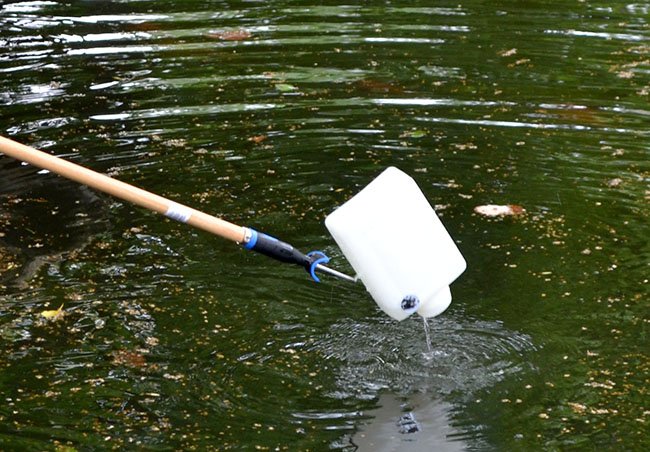DIY Swing Sampler
Allows easy sampling from pontoon boats
Many of us collect water samples out of canoes or kayaks. These human-powered watercraft are easy to deploy and put the sampler close to the water. However, on some lakes it isn’t feasible (or safe) to paddle to your sample site. Many volunteers use pontoon boats. These are fine boats for most any water activities, their only fault being that the decks are so high off the lake that the sampler must lie down on their stomach to reach the water. Even then, getting an “elbow deep” sample is difficult, if not impossible.
Craig Pullman, LMVP volunteer at Table Rock Lake, has the answer. By drilling a hole in a sampling bottle and inserting a small paint roller, Craig can now sample comfortably from the deck of his boat without having to lie down. He graciously shared his building plans with me and now I’m sharing them with you. If you want to build one of these, let me know and I’ll send you an extra sample bottle. Assuming you have a drill and drill bit, all other required parts can be picked up at a hardware store for about $10. You may already have everything you need in your garage already.
Materials:
Paint roller (~$4) and extension handle (~$4)
At least 2 fender washers (~ $0.50)
Something to keep the bottle from sliding off the roller. Examples include: JB Weld, locking nuts, shaft retainer clips ($1 to $5)
1/4" drill bit and drill
Construction is straightforward. A paint roller is inserted through a hole drilled in the corner of a sample bottle and washers keep the bottle from falling off. You’ll need to attach the washers somehow. I used JB Weld, but Craig used a die to cut threads in the end of the roller and used a locking nut to hold the washer on. There are also clips that could be used, called “shaft retainers.” These are simply pushed onto the metal part of the paint roller. When the construction is complete, thread a handle into the end of the roller that is long enough to reach about 12 inches into the water.
This swing sampler is very simple to use. When held in one orientation, the bottle is mouth-down. The handle can be rotated 180 degrees to point the mouth-up. With the bottle in the mouth-up position, brush aside the surface layer of the water with bottom of the sample bottle. Rotate the handle to put the bottle in mouth-down position. Plunge the sample bottle about 12 inches under the surface. Rotate the handle again to mouth-up position. Air will escape the bottle and it will fill with lake water.
Any volunteers that would like to make one of these can send me an email at tony@LMVP.org, or call me at 573-882-5430 to request a sample bottle.
Using the sampler
Triple rinse everything with lake water (this new device and sample bottle)
Swipe the surface of the lake to clear the debris. Do this even if you don't see debris.
Rotate handle so mouth of bottle faces downward
With the mouth still facing downward, plunge the bottle a foot or so below the surface (this will take some effort!) and rotate handle 180 degrees to fill bottle
Pour water from sampling device into your sample bottle, filling the bottle 1/3 full
Repeat twice more, partially filling the sample bottle each time until it's full.





